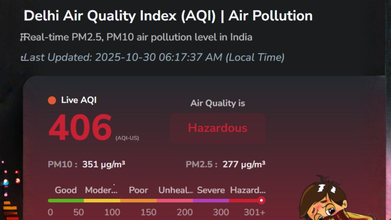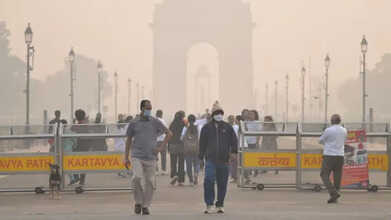- Health Conditions A-Z
- Health & Wellness
- Nutrition
- Fitness
- Health News
- Ayurveda
- Videos
- Medicine A-Z
- Parenting
- Web Stories
FDA Approves New Covid Vaccine For Kids With Selective Eligibility

Credits: Canva
The U.S. Food and Drug Administration (FDA) has granted full approval to Moderna’s COVID-19 vaccine, Spikevax, for children aged 6 months to 11 years — but with a critical condition: it’s only approved for those with underlying medical conditions that put them at higher risk for severe outcomes from COVID-19. This decision marks a shift in the federal approach to pediatric vaccinations, with implications that stretch beyond individual health to the national conversation around public trust in vaccines.
Until now, Moderna’s pediatric vaccine had been administered under emergency use authorization (EUA), a fast-track mechanism used throughout the pandemic. Thursday’s announcement confirms the FDA has approved a supplemental Biologics License Application (sBLA) for Spikevax in children under 12, marking the first COVID vaccine for kids in the U.S. to receive full licensure.
But the approval is narrow: it applies only to children with medical vulnerabilities — such as asthma, congenital heart disease, or immunocompromising conditions — who face higher risks of hospitalization or severe complications from COVID-19.
Also Read: UN Warns Millions Could Die By 2029 If US Cuts HIV Funding
This development aligns with evolving U.S. health policy, particularly since Health Secretary Robert F. Kennedy Jr. made sweeping changes to COVID-19 vaccine guidance earlier this year.
In May, RFK Jr. declared that routine COVID-19 vaccinations would no longer be recommended for healthy children and pregnant women. The decision was not made in consultation with the broader scientific community or advisory boards, and it drew swift backlash from public health experts.
Compounding the controversy, Kennedy dismantled the CDC’s Advisory Committee on Immunization Practices (ACIP) — the independent body of scientists that has advised U.S. vaccine policy for decades — and replaced all 17 members with just seven new appointees, many of whom have documented anti-vaccine stances.
Major medical organizations have since filed lawsuits, arguing that Kennedy’s directives ignore established science and pose a significant public health risk, particularly in light of data showing that infants and toddlers remain vulnerable to serious illness from COVID-19.
Here’s the thing — while healthy children may generally experience milder COVID-19 symptoms, they’re not immune from severe outcomes. In fact, babies under 6 months have the second-highest hospitalization rate for COVID-19, right behind adults aged 75 and older. And kids between 6 and 23 months are hospitalized at similar rates to adults in their early 60s, according to data recently presented to the ACIP before it was disbanded.
Children under 6 months can’t be vaccinated. But those between 6 months and 11 years, especially those with health conditions, still benefit greatly from immunization. Moderna’s CEO, Stéphane Bancel, emphasized the urgency, “COVID-19 continues to pose a significant potential threat to children, especially those with underlying medical conditions. Vaccination can be an important tool for protecting our youngest against severe disease and hospitalization.”
What the New Approval Means for Parents?
Parents of children aged 6 months to 11 years who fall into at-risk categories now have the option of a fully FDA-approved COVID-19 vaccine — not just one available under emergency use. For these families, the approval brings an added layer of reassurance about safety, efficacy, and regulatory oversight. According to Moderna:
- Children ages 6 to 23 months who haven’t previously received a COVID-19 vaccine will need two doses, spaced one month apart.
- Children over 2 years who have already been vaccinated, or are starting fresh, will need just one booster shot.
Moderna says its updated vaccine will be made available in time for the 2025-26 respiratory virus season.
Why Some Experts Still Recommend Vaccinating All Eligible Children?
While federal policy now limits vaccination recommendations, the CDC has kept the door open, stating that COVID-19 shots “remain an option” for healthy children if parents and their pediatricians agree it’s warranted. Vaccination doesn’t just prevent infection — it lowers the chance of serious outcomes like:
- MIS-C (Multisystem Inflammatory Syndrome in Children), a rare but severe complication
- Long COVID symptoms, which can include fatigue, cognitive issues, and respiratory problems
Transmission to vulnerable adults, such as grandparents or teachers with underlying conditions
Additionally, children who are vaccinated are less likely to miss school, more likely to safely participate in sports and social activities, and can contribute to broader community protection.
The selective nature of this FDA approval speaks to a deepening divide in how U.S. health policy is being shaped — one that pits evolving scientific data against a rising tide of political skepticism.
As the CDC continues to endorse COVID-19 vaccination for everyone aged 6 months and older, Kennedy’s reversal of longstanding recommendations has raised alarms among epidemiologists, pediatricians, and public health officials who warn that scaling back vaccine guidance may undermine public trust and increase risk for vulnerable populations.
Meanwhile, Moderna’s stock saw a modest 2% rise in premarket trading, signaling investor confidence in the vaccine’s continued relevance — especially for immunocompromised populations.
This isn’t just another vaccine approval — it’s a mirror of where the U.S. stands on public health, science, and trust in institutions. With the FDA’s endorsement of Moderna’s Spikevax for select children, parents of vulnerable kids now have a fully approved safeguard.
The mixed messaging between the FDA, the CDC, and the federal health secretary may leave many families confused about what’s best for their children. In this climate, pediatricians will play a crucial role in helping families make informed decisions based on science, not politics.
Delhi Air Pollution: Damage Risks Are Beyond Your Lungs, It Can Affect Your Kidney Too, According To Doctor

Credits: AQI.in
As of 6.17am on October 30, 2025, the AQI in Delhi is recorded at 406, and falls under the category 'Hazardous'. Major pollutants are PM2.5, PM10, CO, So2, No2, and O3. We have long known air pollution's impact on respiratory health and lungs, however, it is beyond that. With levels as high as 'hazardous', the pollution could also damage our kidneys.
Dr Sanjeev Gulati, nephrologist in Fortis, Delhi, writes that the detrimental effects of air pollution are not only evident in the respiratory and circulatory system, but it can also extend to renal function. He writes, "The kidneys are particularly vulnerable to the toxic effects of environmental pollutants due to their critical role in filtration. Environmental and occupational exposure to pollutants remains a common cause of kidney disease globally, especially in developing countries."
Up to 22% of the global disease burden and 23% of deaths are attributed to environmental pollution. There have been various studies that show the long-term exposure from particulate matter and how it is linked to an increased risk of membranous nephropathy and decline in renal function.
What Is Membranous Nephropathy?
It is a kidney disease caused by the damage to the kidney's filtration system. This could lead to significant protein leakage into the urine. This could happen due to the PM exposure.
In fact, a 2025 study published in the Journal of the American Society of Nephrology highlighted the role of air pollution in the rising risk of new kidney diseases. The study was able to track 2.5 million veterans, who were free of kidney diseases in 2003 and 2004, over an average of 8.5 years. The researchers then compared their health outcomes to air pollution levels. The study then found that for every 10 microgram increase in pollution per cubic meter of air, there was a 25 to 37% increase in new kidney disease case, a 36% rise in rapid kidney function decline, and a 31% increase in the risk of kidney failure requiring dialysis.
How Does Pollution Damage Your Kidney?
Dr Sean Hashmi, MD, MS, FASN, a board-certified nephrologist and obesity medicine specialist in the Southern Carolina, US, in a video on his YouTube channel that he uploaded to explain the impact of air pollution on kidney says, "your kidney is force to process a chemical soup day after day after day. And the main villain here is PM2.5."
Dr Hashmi notes that once the PM2.5 is in your bloodstream, your body treats them like foreign invaders. "This triggers powerful inflammation throughout your system. Inflammation is your immune system's response to injury and threat. However, when inflammation becomes chronic [due to long exposure of PM2.5], it can damage healthy tissues."
He says, as a result, these particle-filled blood arrives in your kidney. "Your kidneys have millions of tiny filters glomerulus, they are like cluster of blood vessels that act like coffee filters for your blood. The constant flow of abrasive particles creates low-grade sand blasting on these fragile filters. Over years this leads to permanent scarring and reduced kidney functions."
A Mysterious New Fungal Infection Is Spreading In UK Hospitals, Health Expert Warns

Credits: Canva
Health officials across the UK are on alert after identifying a new fungal infection spreading in hospitals. Known as Candidozyma auris (C. auris), this yeast has been named a critical priority pathogen by the World Health Organisation (WHO) because of its growing resistance to treatment and potential danger to vulnerable patients. The UK Health Security Agency (UKHSA) is now working with NHS England and other health partners to monitor rising detections of C. auris, which until recently had been rare in the country. Globally, the infection has been linked to a high death rate, raising concern for hospitalised patients with weakened immune systems.
What Is Candidozyma Auris?
C. auris is a type of fungus that can lead to severe infections, particularly among those who are already ill. Some strains have shown resistance to multiple antifungal drugs, making treatment difficult. It spreads most often in hospitals and long-term care facilities. According to the Cleveland Clinic, infections may include:- Ear infections
- Wound infections
- Urinary tract infections (UTIs)
- Bloodstream infections that can spread throughout the body
Unlike other Candida species, C. auris does not typically live naturally on the body. People usually contract it from contaminated hospital surfaces or from someone who already has the infection. For healthy individuals, the risk of infection remains low.
How Common Are Candidozyma Auris Infections?
C. auris remains uncommon but is considered an emerging infectious disease due to the rising number of reported cases since 2019. Healthcare professionals are increasing infection-control measures to contain its spread in hospitals and care homes.Symptoms Of Candidozyma Auris
The symptoms vary depending on which part of the body is infected. Common signs include:- Fever
- Chills
- Fatigue or extreme tiredness
- Low blood pressure
- Rapid heartbeat (tachycardia)
- Low body temperature (hypothermia)
- Ear pain, pressure, or a sense of fullness (in ear infections)
According to a UKHSA statement, C. auris was first discovered in 2009 in the ear of a patient in Japan and has since been detected in over 40 countries across six continents. The agency explains that the fungus is particularly concerning because it can survive for long periods on surfaces—even in hospital settings—and is often resistant to both standard medical treatments and disinfectants.
Since 2015, several long-lasting outbreaks of C. auris have occurred in UK hospitals, requiring intensive control measures to stop further transmission. Peaks in cases have mostly been linked to these outbreaks.
Can Candidozyma Auris Be Cured?
C. auris infections can often be treated with a type of antifungal medication called echinocandins. However, certain strains are developing resistance, making them more difficult to cure. In such cases, doctors may need to combine different drugs to eliminate the infection. Before starting any medication, it is important to consult a qualified healthcare professional for proper diagnosis and treatment advice.
Delhi’s Artificial Rain Plan To Fight Toxic Smog Fails— Here’s Why It Didn’t Work

Credits: PTI
Artificial Cloud Seeding Delhi: Delhi has long struggled with toxic air. The city often records high pollution levels throughout the year, and in an effort to provide cleaner air to residents, the Delhi government has been exploring cloud seeding or artificial rain for several months.
After more than five decades, Delhi finally carried out cloud seeding trials to trigger artificial rain and bring down rising pollution levels. The project was a joint effort between the Delhi government and the Indian Institute of Technology (IIT) Kanpur, conducted in areas such as Burari, Karol Bagh, Mayur Vihar, and Badli.
However, the experiment failed, as the India Meteorological Department (IMD) did not record any rainfall in the city.
Why Cloud Seeding Failed in Delhi?
According to an NDTV report, IIT Kanpur Director Manindra Agrawal said the attempt was “not completely successful” because the clouds did not have enough moisture. “For rain to form, moisture levels of at least 50 percent are ideal,” he said. “Today’s clouds only had about 15–20 percent moisture, which reduced the chances of rainfall.”
Despite the low humidity, Agrawal said the exercise gave researchers valuable experience and confidence that the method could work under more favorable conditions. While Delhi saw no rainfall, small traces were recorded in Noida (0.1 mm) and Greater Noida (0.2 mm). Two more flights will be carried out once suitable clouds appear.
A report released by the Delhi government on Tuesday evening showed a slight drop in pollution levels in areas where the seeding took place. According to PTI, PM2.5 levels fell marginally in Mayur Vihar, Karol Bagh, and Burari. Environment Minister Manjinder Singh Sirsa called it a “major scientific step” in tackling air pollution and said more trials, possibly up to 10, will be conducted until February if the results remain encouraging.
What Is Cloud Seeding?
Cloud seeding involves adding substances like silver iodide or dry ice to clouds to encourage rainfall or snowfall, reduce hail, or clear fog. It can be carried out using aircraft, rockets, or ground-based equipment.
The formula developed by IIT Kanpur includes silver iodide nanoparticles, iodised salt, and rock salt. These particles act as ice nuclei, helping moisture in the clouds condense and form rain. However, the process depends heavily on having the right level of humidity and moisture in the atmosphere.
Will a Third Round of Cloud Seeding Take Place?
A third round of trials is likely later this week, depending on IMD confirmation of suitable cloud conditions. Similar operations are expected in the coming days. Sirsa told ANI that IIT Kanpur has been collecting large-scale samples during the experiments and will submit a detailed report soon.
Globally, cloud seeding has produced mixed outcomes. China has reported success with using rockets, cannons, and drones to manage rainfall, including before the Olympics. In contrast, the United Arab Emirates faced criticism after last year’s floods in Dubai, raising questions about the method’s safety and reliability.
© 2024 Bennett, Coleman & Company Limited

